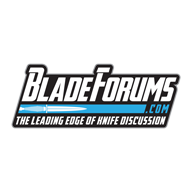I'm making some edc knives out of AEB-L about an 1/8" thick, 8" long overall. Any advice/ warnings with this steel is welcome! I cut my blank out and noticed there's pretty significant bend between the blade and handle. Trying to figure out the best way to correct that bend.
I can flatten it on my grinder- I don't have the nice surface grinding attachment- this is not perfect and takes some time. I'm anticipating doing this for the rest of the knives I make with this material.
I can maybe cold hammer it? This would be quick, but not sure if this would cause issues.
I have a forge, but not a temp controlled oven, so I'm shipping them out for HT.
Do I even need to correct it? I believe this will be plate quenched, so with any luck it will be straightened out and stay that way.
Thoughts?
I can flatten it on my grinder- I don't have the nice surface grinding attachment- this is not perfect and takes some time. I'm anticipating doing this for the rest of the knives I make with this material.
I can maybe cold hammer it? This would be quick, but not sure if this would cause issues.
I have a forge, but not a temp controlled oven, so I'm shipping them out for HT.
Do I even need to correct it? I believe this will be plate quenched, so with any luck it will be straightened out and stay that way.
Thoughts?

